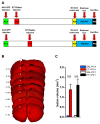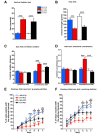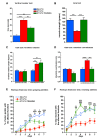Focal Stroke in the Developing Rat Motor Cortex Induces Age- and Experience-Dependent Maladaptive Plasticity of Corticospinal System
- PMID: 28706475
- PMCID: PMC5489564
- DOI: 10.3389/fncir.2017.00047
Focal Stroke in the Developing Rat Motor Cortex Induces Age- and Experience-Dependent Maladaptive Plasticity of Corticospinal System
Abstract
Motor system development is characterized by an activity-dependent competition between ipsilateral and contralateral corticospinal tracts (CST). Clinical evidence suggests that age is crucial for developmental stroke outcome, with early lesions inducing a "maladaptive" strengthening of ipsilateral projections from the healthy hemisphere and worse motor impairment. Here, we investigated in developing rats the relation between lesion timing, motor outcome and CST remodeling pattern. We induced a focal ischemia into forelimb motor cortex (fM1) at two distinct pre-weaning ages: P14 and P21. We compared long-term motor outcome with changes in axonal sprouting of contralesional CST at red nucleus and spinal cord level using anterograde tracing. We found that P14 stroke caused a more severe long-term motor impairment than at P21, and induced a strong and aberrant contralesional CST sprouting onto denervated spinal cord and red nucleus. The mistargeted sprouting of CST, and the worse motor outcome of the P14 stroke rats were reversed by an early skilled motor training, underscoring the potential of early activity-dependent plasticity in modulating lesion outcome. Thus, changes in the mechanisms controlling CST plasticity occurring during the third postnatal week are associated with age-dependent regulation of the motor outcome after stroke.
Keywords: corticospinal system; critical period; development; maladaptive plasticity; stroke.
Figures









Similar articles
-
Plasticity in One Hemisphere, Control From Two: Adaptation in Descending Motor Pathways After Unilateral Corticospinal Injury in Neonatal Rats.Front Neural Circuits. 2018 Apr 12;12:28. doi: 10.3389/fncir.2018.00028. eCollection 2018. Front Neural Circuits. 2018. PMID: 29706871 Free PMC article.
-
Rewiring of the corticospinal tract in the adult rat after unilateral stroke and anti-Nogo-A therapy.Brain. 2014 Mar;137(Pt 3):739-56. doi: 10.1093/brain/awt336. Epub 2013 Dec 18. Brain. 2014. PMID: 24355710 Clinical Trial.
-
Back seat driving: hindlimb corticospinal neurons assume forelimb control following ischaemic stroke.Brain. 2012 Nov;135(Pt 11):3265-81. doi: 10.1093/brain/aws270. Brain. 2012. PMID: 23169918
-
Corticospinal circuit plasticity in motor rehabilitation from spinal cord injury.Neurosci Lett. 2017 Jun 23;652:94-104. doi: 10.1016/j.neulet.2016.12.003. Epub 2016 Dec 6. Neurosci Lett. 2017. PMID: 27939980 Review.
-
Motor system plasticity after unilateral injury in the developing brain.Dev Med Child Neurol. 2017 Dec;59(12):1224-1229. doi: 10.1111/dmcn.13581. Epub 2017 Oct 3. Dev Med Child Neurol. 2017. PMID: 28972274 Free PMC article. Review.
Cited by
-
Targeting thalamocortical circuits for closed-loop stimulation in Lennox-Gastaut syndrome.Brain Commun. 2024 May 7;6(3):fcae161. doi: 10.1093/braincomms/fcae161. eCollection 2024. Brain Commun. 2024. PMID: 38764777 Free PMC article.
-
Early impoverished environment delays the maturation of cerebral cortex.Sci Rep. 2018 Jan 19;8(1):1187. doi: 10.1038/s41598-018-19459-y. Sci Rep. 2018. PMID: 29352131 Free PMC article.
-
Clinical Evaluation of Different Treatment Strategies for Motor Recovery in Poststroke Rehabilitation during the First 90 Days.J Clin Med. 2021 Aug 21;10(16):3718. doi: 10.3390/jcm10163718. J Clin Med. 2021. PMID: 34442014 Free PMC article.
-
Rodent Models of Developmental Ischemic Stroke for Translational Research: Strengths and Weaknesses.Neural Plast. 2019 Apr 4;2019:5089321. doi: 10.1155/2019/5089321. eCollection 2019. Neural Plast. 2019. PMID: 31093271 Free PMC article. Review.
-
Should We Care About Early Post-Stroke Rehabilitation? Not Yet, but Soon.Curr Neurol Neurosci Rep. 2019 Feb 20;19(3):13. doi: 10.1007/s11910-019-0927-x. Curr Neurol Neurosci Rep. 2019. PMID: 30788609 Review.
References
MeSH terms
LinkOut - more resources
Full Text Sources
Other Literature Sources
Medical
Research Materials

